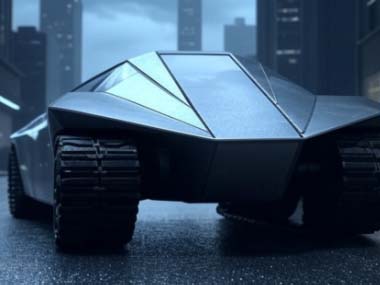Cyber Shell
Vehicle Specification: Triangular Prism Utility Vehicle
General Description:
- Design: Triangular prism shape with a sleek, aerodynamic profile for reduced air resistance and a futuristic aesthetic.
- Purpose: Designed for urban exploration, utility, or military applications, emphasizing mobility over rough urban terrain.
Dimensions:
- Length: Approximately 5 metres
- Width: Around 2.6 metres at the base, narrowing towards the top.
- Height: About 2 metres, allowing for a low centre of gravity.
Chassis and Structure:
- Frame: Constructed from high-strength aluminium or composite steel materials for weight reduction and durability.
- Body: Likely made from carbon fibre or advanced polymers with integrated stealth coatings to reduce radar cross-section.
Mobility:
- Tracks: Continuous rubber tracks for enhanced traction on wet, uneven, or debris-strewn urban surfaces. Tracks could be modular to adjust width or tread pattern for various terrains.
- Suspension: Advanced suspension system, possibly hydraulic, to absorb shocks and maintain stability over rough terrain with auto adjusting for different surfaces and at different velocities.
Power and Propulsion:
- Engine: Electric motor system with battery packs, possibly supplemented by a small internal combustion engine or hydrogen fuel cells for extended range.
- Transmission: Continuously variable transmission (CVT) to optimize power delivery and efficiency.
Performance:
- Speed: Capable of speeds up to 120 mph on flat surfaces, with reduced speed for stability on rough terrain.
- Range: With a fully charged battery and fuel, it could operate for 350 - 500 miles, depending on terrain and usage.
Interior and Controls:
- Control System: Likely autonomous driving capabilities with manual override options. The interior might be minimalistic, focusing on control interfaces rather than passenger comfort.
- Seating: One or two seats, designed ergonomically for long missions but not for comfort.
Safety and Utility Features:
- Armor: Potential for lightweight ballistic armour to protect against small arms fire or debris with an angular design to absorb more energy.
- Sensors: Advanced sensor suite including LIDAR, cameras, and possibly thermal imaging for navigation and threat detection in low visibility or at night.
- Communication: Equipped with secure communication systems, potentially including satellite links for extended operational range.
Environmental Impact:
- Emissions: Low emissions if primarily electric; hybrid models would still aim for minimal environmental impact through efficiency and onboard fuel creation.
- Noise: Designed to be quiet, enhancing stealth in urban operations.
Deployment:
- Applications: Suitable for reconnaissance, disaster response, or as a platform for mounting specialized equipment like drones or surveillance gear.
Maintenance:
- Durability: Built for rugged use with easily replaceable parts, especially the tracks and sensors.
- Upgradability: Modular design allows for easy upgrades in technology or mission-specific equipment.
This speculative spec provides a broad outline of what such a vehicle might entail, considering its design and potential usage scenarios. For a real-world application, detailed engineering studies, testing, and regulatory compliance checks would be necessary.
Keywords
triangular prism utility vehicle urban exploration military applications aerodynamic profile futuristic aesthetic high-strength aluminium composite steel carbon fibre stealth coatings rubber tracks modular tracks hydraulic suspension electric motor battery packs hydrogen fuel cells cvt transmission autonomous driving ballistic armor lidar thermal imaging secure communications low emissions stealth operations reconnaissance disaster response modular design
